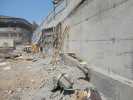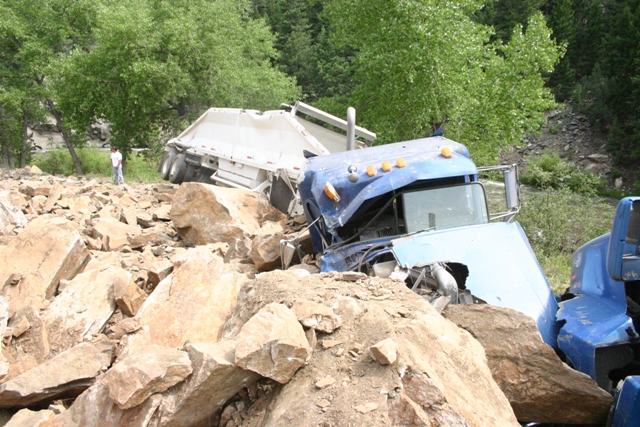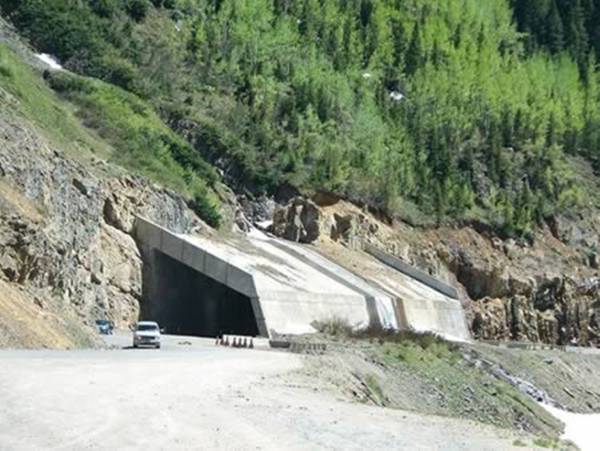Rockfall and avalanche protection
Changeable climate, anthropogenic impact, seismic processes in the bowels of the Earth can have dangerous consequences in the form of rockfalls and landslides [Fugure 1].
Fugure 1. Rockfall’s consequences
1) Rockfalls hamper movement in the highlands Of British Columbia, Canada;
2) Destructive rockfall due to earthquake, New Zealand;
3) Clear Creek canyon, Colorado, USA;
4) Rockfall in Thailand.
Rockfall protection system is a key element in the design of new and maintenance of existing sections of roads, railways and other facilities located in mountainous areas. The availability of these systems has a direct relationship to the safe operation of existing infrastructure.
The concept of rockfall. The studied parameters
Rockfall - the collapse of large stone blocks, fragments of rocks and just a free fall of stones on the mountain slopes under the influence of gravity. The reason for the rockfall processes formation is the ground masses separation from the parent rock. This is the result of weathering, earthquake, erosion of surface, man-made effects, etc.
One of the main investigated parameters in the study of rockfall processes and designing of engineering protection constructions are the stone trajectory and the impact energy of the stone.
- the average diameter d of the blocks;
- volume and weight of an unstable array;
- the angle of the slope;
- slope configuration (cross-section diagram);
- physical and mechanical characteristics of the soil.
The trajectory of the rockfall is described by the following parameters:
The impact energy of the stone is experimentally determined and depends on the following factors:
- volume of blocks;
- weight of blocks;
- speed of falling stones.
In this case, the impact force Py is determined by the type of anti-dump structure used. So, for example, when using a cushioning pile, Py decreases with increasing thickness of the structure.
When finding the above parameters, an important role is played by the configuration (cross-sectional diagram) of the slope, on which the calculated velocity of the earth fragments depends.
Traditional protection systems against rockfalls
The current regulations of the Russian Federation interpret the following classification of buildings and constructions:retaining structures intended to prevent shifting and collapse of the soil when it is impossible or economically impractical to change the slope relief.
These category include:
- buttresses - individual supports embedded in the stable layers of the soil to support individual rock masses, для подпирания отдельных скальных массивов;
- bowls - massive structures to maintain unstable slopes;
- facing wall - for protection of soil from weathering and fraying;
- anchorages - as an independent holding structure in the form of separate rock blocks fastening to the strong array on the rocky slopes.
- catching constructions and devices - walls, gabions, grids, shafts, trenches.
- rockfall protection galleries.
Until recently, rockfall protection galleries were the only technical solution aimed at protecting the collapsing sections of railways, federal highways and pedestrian routes. Indeed, galleries made of precast or monolithic reinforced concrete are used as a reliable engineering construction all over the world [Figure 2].
Figure 2. Rockfall protection galleries in the world
1) Rockfall protection gallery on the Circum-Baikal railway, Russia;
2) Rockfall protection gallery on the Circum-Baikal railway, Russia;
3) Rockfall protection gallery, USA;
4) Dudley Ward Tunnel, Gibraltar.
Advantages of rockfall protection galleries:
- + the wide range of applications (estimated impact energy 200-3000 kJ),
- + the possibility of damping the device, allows you to mitigate the impact.
And also they have the list of disadvantages:
- falling blocks with an impact energy of 5000-8000 kJ destroy reinforced concrete structures;
- huge labor costs in the construction of capital structures on the slopes;
- due to labor costs, the high cost of construction;
- capital construction entails intervention in the current environmental situation on the slope.
Flexible rockfall protection barriers
The latest developments in the field of protection against rockfalls using a flexible capture systems (flexible rockfall barriers) provide cost-effective protection, even in those areas where previously this was considered impossible or too costly.
This technical solution has a wide scope of application, which makes it an alternative to traditional slope protection systems.
Barriers can absorb rock strokes with energy up to 8000 J, which is comparable to the fall of a 20 metric tons block at a speed of more than 100 km/h.
The absorbing characteristics of the barriers are obtained by full-scale tests, which are carried out under the strictest conditions of vertical drop in accordance with the European standard ETAG 027 and Swiss standards for typical barriers tests.
Advantages of the solutions with flexible rockfall barriers:
- smaller amount of work, high speed installation of structures;
- lightness;
- cost-efficiency-the individual elements of the system are perfectly coordinated with each other, which minimizes the amount of consumables;
- environmental-friendly solutions - flexible barriers do not violate the landscape.
Features of the calculation and flexible barriers application experience
Calculation of the probable rockfall trajectory
Calculation of the probable rockfall trajectory is performed in order to determine the design speed of the stone and to choose parameters of the protection structures. Rockfall modeling is carried out in RockFall software complex (Germany) on the basis of natural slope geometry (cross-section) and expected size and volume of rock fragments.
Figure 5. Graphical results of the probable rockfall trajectory calculation (left) and the maximum impact energy (right) in the software package RockFall
«Pontis» project, Switzerland.
Federal highway in Southwest Switzerland, Canton of Valais, in the vicinity of Tunnel de Pontis, received the rockfall with impact energy of falling stones up to 2000 kJ every 10 years. Blocks of 1.0-2.5 m3 fell on the road from a height of more than 100 m.
Figure 6. The situation in the vicinity of Tunnel de Pontis, Switzerland (left) and the cross-section of the investigated slope with the probable rockfall trajectories (right)
In order to stabilize the situation on the slope, three technical solutions were considered and the estimated cost was calculated:
1 Reconstruction of the existing tunnel;
2 Construction of concrete rockfall gallery for dangerous section of highway;
3 Installation of a flexible gallery of rockfall barriers over a dangerous section of the highway.
Properly designed barriers form an effective, multi-functional protective system. computer program FARO is designed to calculate the required parameters of the barriers, depending on the rockfall and terrain characteristics.
Snow load (4 kN/m2) 1000 m above sea level is taken into account when calculating barriers:
- 100% snow load [Fig. 8, left];
- 30% of maximum snow load + impact stone (2000 kJ) [Fig. 8, right].
Installation of the rockfall gallery was performed without overlapping the road.
Full-scale tests of the flexible rockfall barrier for impact energy up to 8000 kJ.
In October 2011 GBE-8000A barrier was tested by vertical drop at the special polygon in Walenstadt (Switzerland). In the maximum energy level test (MEL-test), the barrier stopped a 20-ton concrete block flying freely from a height of 43 m at a speed of 103 km/h, which corresponds to an energy of 8,000 kJ. The maximum deviation of the structure was 8.5 m.
In comparison with the protective dam for 8000 kJ energy, the GBE-8000A barrier requires significantly less material. About 100 tons of material are required for the construction of the berm and the dumping of the running meter of the dam. The weight of the GBE-8000A barrier is only about 1 ton per running meter.
Rockfall protection system is a key element in the design of new and maintenance of existing sections of roads, Railways and other facilities located in mountainous areas. The availability of these systems has a direct relationship to the safe operation of existing infrastructure.
One of the main investigated parameters in the study of rockfall processes and designing of constructions of engineering protection of territories are the trajectory of the stone and the energy of impact of the stone on the prospective protective design.The latest developments in the field of protection against rockfalls using a flexible capture systems (flexible rockfall barriers) provide cost-effective protection, even in those areas where previously this was considered impossible or too costly.
Small popularity of flexible solutions to protect against rockfalls in the Russian Federation due to the absence of deeply-defined regulatory framework. At the Department of Bases and foundations of the Kuban state agrarian University in cooperation with GEOTECH and Geobrugg AG (Switzerland) conducted research in the field of creation of modern methods of designing and calculation of rockfall engineering constructions for protection of territories and objects of infrastructure.
































































